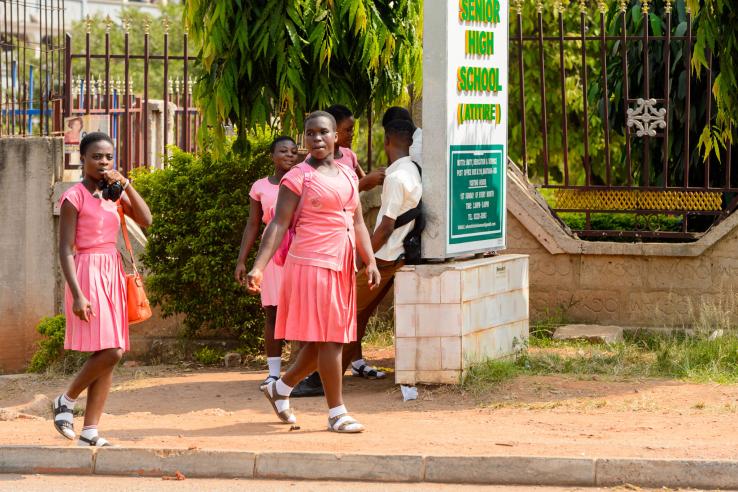Want to get girls to school in sub-Saharan Africa? Tackle poverty

This post was originally published on African Arguments on April 28, 2022, and is part of an ongoing series. Read the other blogs in the series on preparing households for shocks through universal basic income; obstacles to accurately identifying those in need of social assistance; the benefits and challenges of digital IDs; and how different electricity billing systems may impact energy access.
A famous African adage says, “if you educate a man, you educate an individual, but if you educate a woman, you educate a nation.” The value and benefits of educating a female child cannot be overemphasised in today’s world.
And yet, female education remains a key challenge in sub-Saharan Africa, which is home to the largest population of out-of-school girls. The Covid-19 pandemic has further aggravated dropouts for adolescent girls, and up to 5 million girls globally might never return to school.
In a bid to keep girls enrolled, governments, donors, and development partners are dedicating millions of dollars in funding. In 2021, G7 leaders pledged US$2.75 billion to support the education of 40 million girls over the next five years. The Global Partnership for Education (GPE) has declared 12 years of education for girls as one of its main priorities.
With this injection of funding and the growing recognition that more needs to be done to keep girls in school, governments and their partners are testing a wide range of innovative approaches to address gender-specific barriers to school participation and learning – from interventions to address in-school gender-based violence to integrating supplemental female teachers to support gender-sensitive pedagogy. These developments are exciting, and research needs to keep pace to evaluate the impact of such innovative strategies on girls’ enrolment.
However, we cannot forget that poverty remains a key barrier to school enrolment, especially following the economic disruptions triggered by the Covid-19 pandemic. Recent data shows that a higher proportion of girls report financial constraints as a primary challenge to pursuing their education and career aspirations due to the pandemic.
These constraints may be particularly felt in low-income countries, where 63 percent of states still charge secondary school tuition. Even when there are no fees, parents often still have to pay for uniforms, textbooks, and school supplies.
“I stopped going to school because my father doesn’t have the means to continue paying for exams and school materials,” said a girl from Katsina State in Nigeria, where we did a data collection in 2021 for the design of the AGILE life skills intervention. Another mentioned, “I was in boarding school and they could not afford it anymore so they decided to marry me out.”
Economic restrictions may also lead to other gender-specific barriers to school access. Evidence from the Ebola outbreak in Sierra Leone suggests that girls dropped out of school mainly due to pregnancies, the majority of which derived from transactional sex that girls engaged in to support themselves and their families.
Can we really hope to tackle dropouts and increase girls’ school enrolment without first addressing the financial constraints families face?
Reducing the cost of schooling can lead to better enrolment
Research finds that reducing costs of schooling has been consistently effective at keeping girls enrolled in school.
School participation is sensitive to costs and incentives, especially for girls, who are often the disadvantaged gender. Reducing the costs of education through cash or in-kind transfers is a proven way to increase enrolment and attendance rates. For example, over 18 impact evaluations on Conditional Cash Transfers (CCTs) have shown positive and consistent results on increasing enrolment.
Seminal research by Duflo, Dupas, and Kremer in Ghana tested the impact of providing a four-year, scholarship to low-income, academically qualified students in senior high school. The study found that girls who received the scholarship were 29 percentage points more likely to enrol and 26 percentage points more likely to complete senior high school relative to the comparison group. These girls were also 8 percentage points more likely to enrol and 4 percentage points more likely to complete tertiary education. Moreover, the study found that many of the girls who made it to tertiary education would not have attended secondary school without the scholarship.
The increased educational retention also translated into a fertility decline and increased labour participation – girls who received scholarships were 7 percentage points less likely to have ever been pregnant and 4 percentage points more likely to be public sector employees. The study also found substantial intergenerational effects of the scholarships – children of the girls who received the scholarships were less likely to die before age five and did better on cognitive development tests. These findings confirm and further strengthen the case for education subsidies as a transformational vehicle to educate and empower women.
While sceptics might argue that transfers can be expensive to deliver, the last decade has taught us much about making them leaner
Design details matter in determining the cost of subsidy programmes. Decisions around the target audience, choices on modes of delivering the transfer, and timing of delivery could all make cash transfer programmes less expensive.
- Reducing the size of the transfer: In Malawi, researchers tested the effects of a range of cash transfer amounts on school enrolment. The results showed that giving girls a conditional cash transfer of US$5 per month prompted a similar increase in school enrolment relative to a conditional cash transfer of US$15 per month. In this case, smaller transfers were more cost-effective than the larger transfers. While we can’t hope to prevent dropouts with pennies, we may be able to make a dent with just a few dollars.
- Targeting effectively: Targeting subsidies by identifying those who need the transfer most could also help reduce costs. Targeting methods are increasingly varied and sophisticated, triggered by technological advances and the onset of the Covid-19 pandemic, which has made social protection programmes more necessary than ever. Where financial constraints make free secondary education for all a challenge, a targeted approach may be more cost-effective. Calculations in the paper from Ghana suggest that a “free senior high school for all” policy would pay for 3.6 years of education for each additional 0.5 years of schooling attained. Instead, the scholarship paid for 3.08 years of education for each 1.25 additional years of education attained. Therefore, targeting interventions to students based on characteristics that may predict lower senior high school enrolment – such as female students from disadvantaged backgrounds who have passed national examinations – could be more cost-effective.
- Loosening conditionality through labelling or in-kind transfers: The myth that households that receive subsidies spend them on useless, “temptation” goods or become lazy and dependent on state finances has largely been debunked. Designing programmes with looser conditionality can be dignifying and serve to eliminate monitoring costs. A program in Morocco found that labelling a small cash transfer for parents of school-aged children in poor rural communities as an “education support program” improved enrolment and attendance without needing to enforce conditionality by checking children’s attendance. Timing transfers around enrolment calendars may also help ensure that they are used for school fees. Overall, even small, targeted and unconditional cost-reduction schemes may lead to significant improvements in enrolment for girls by removing out-of-pocket costs for parents, which are immediate and salient. In Kenya, sixth-grade girls who received free uniforms for two years (equivalent to a total value of US$12) were 3.1 percentage points (16 percent) less likely to drop out of school after three years than their peers who did not receive uniforms (19 percent of whom dropped out).
We cannot ignore poverty in our fight to get girls back to school
Providing subsidies for education is an important commitment to make in a post-pandemic context. Fortunately, social protection programmes, which are already implemented in over 186 countries globally, have been further strengthened in response to Covid-19 and are likely to last beyond the pandemic to help citizens respond to shocks.
We have a unique opportunity to shape social protection interventions in a way that drives positive education outcomes for girls. Tying educational objectives to these schemes should be a first order of priority to boost enrolment. When carefully designed – using global evidence to maximise effectiveness and encourage financial responsibility, as well as taking into account the local context, such as the needs of parents – cost-reduction schemes can be an important intervention to boost girls’ enrolment and wellbeing.





